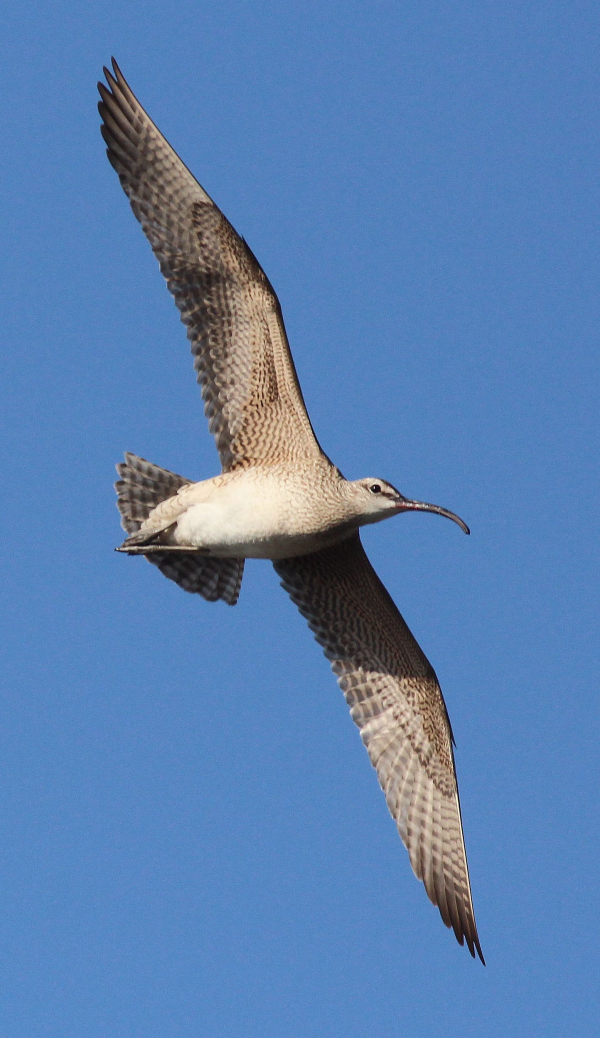
Deveaux Bank is by far the largest Whimbrel roost location known in the world (photo by Paul Konrad).
|
The exciting discovery of an exceptional Whimbrel roost and spring staging area on a coastal island offshore from Charleston, South Carolina, recently led biologists to document nearly 20,000 Whimbrels concentrated during spring migration. This roost site at Deveaux Bank attracts nearly half the Atlantic Flyway population of Whimbrels, and a quarter of all Whimbrels that nest in North America.
Long recognized as critical bird habitat, Deveaux Bank hosts nearly 3,000 nesting pairs of Brown Pelicans, plus nesting Black Skimmers, American Oystercatchers, Royal Terns, Sandwich Terns, Laughing Gulls, and several species of herons and egrets. Luckily, the island is already protected as a state bird sanctuary and designated Important Bird Area.
The discovery of the global importance of Deveaux Bank has sparked a focus on the importance of nocturnal roosts in general, which may be among the most important, rarest, and least-appreciated resources for long-distance shorebird migrants like Whimbrels. At night, these birds need safe places that are elevated enough above the waves of high tides, yet where they are protected from predators like raccoons and large owls.
There are 2 primary populations of Whimbrels in North America: The western population nests from the Northwest Territories along the Mackenzie River Delta into western Alaska, while the eastern population nests south and west of Hudson Bay. Most of the Whimbrels stopping over at Deveaux Bank in great numbers each spring are thought to be “Hudsonian” birds. During fall migration they migrate south through the Great Lakes region to the coast of South Carolina or Georgia, staging in much smaller numbers than during spring. From there, they follow the arc of the Bahamas and Antilles to the northeast coast of South America.
During the day the Whimbrels spread out across an immense area to forage. Fortunately for the birds, the Carolinas and Georgia have the largest expanse of saltmarshes along the Atlantic coast, covering nearly a million acres. Just south of Deveaux Bank is the 350,000 acre ACE Basin Project, a federal-state-private partnership that protects a vast stretch of especially pristine tidal estuaries. Preliminary tracking data, including information from several Whimbrels fitted with transmitters at Deveaux Bank, show some Whimbrels may be commuting up to 30 miles each way between foraging areas and their roost site.
The Whimbrels have plenty of places to feed, but at the end of the day they have few places where they can safely roost. Surveys along the Georgia and South Carolina coastal areas have revealed only 2 other roost sites: Little Egg Island in Georgia, and Tomkins Island just across the state line in South Carolina, each attracting just 1,000 or 2,000 Whimbrels. Deveaux Bank is not only the largest night roost on the Atlantic coast, it is by far the largest Whimbrel roost location known in the world (there are also Whimbrel populations that range across areas in the Old World).
To read more, please refer to the extensive article written by migration researcher Scott Weidensaul that was published in The Living Bird at A Miracle of Abundance as 20,000 Whimbrel Take Refuge on a Tiny Island | All About Birds All About Birds
Scott is also the author of the New York Times bestseller A World on the Wing that chronicles a wealth of interesting bird migration feats and survival mechanisms; see A World on the Wing: The Global Odyssey of Migratory Birds